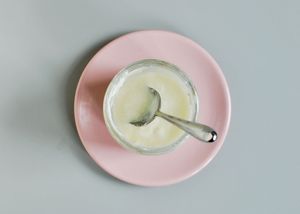During a particularly challenging health period, I was knee-deep in the SCD diet. Part of the protocol involves making your own yoghurt, but there are a lot of rules. It has to be lactose-free, which requires fermenting milk with a specific starter (some strains of bacteria aren’t desirable for SCD-diet followers) for 24 hours at a constant temperature (between 38 and 43°C). Many yoghurt makers – including mine – will nudge above this temperature after a while, so I had to plug it into a dimmer switch and test the ferment throughout the 24-hour period. If you don't have a yoghurt maker, there are other ways . . . A slow cooker, oven with the pilot light on and even a hot-water bottle are all possible. Have a Google and find the best method for you.
All this to say: that’s how you make lactose-free yoghurt. If lactose isn’t an issue for you, you can incubate for 10-12 hours instead. And those not on the SCD diet can use a commercially bought yoghurt to kick things off. Choose an organic one with no added sugar, fillers or weird things. Just yoghurt, with as many different beneficial bacteria strains as possible. Reading ‘contains live bacteria’ on a packet doesn't convince me; I go for the longest list of Greek names: lactobacillus bulgaricus, streptococcus thermophilus, bifidobacterium and the like.
Once you’ve made yoghurt once, you can keep reusing the dregs to make a new batch. If you're using a commercially bought yoghurt as a starter, this process should work around five times before the bacteria can no longer survive. If you're lucky enough to get your hands on an heirloom yoghurt sample (I'm currently looking into buying one online), you'll be able to reuse it indefinitely.
Your bacteria will thrive best if you do so every week, which is why I make only 500 ml at a time. If you (or your family) go through more yoghurt than that in a week, feel free to double or triple the recipe. If you’re going on holiday or need a yoghurt-making break, you can freeze the starter for a few weeks – any longer and you risk losing it. If you need more time away from your starter, it’s best to ask a friend to babysit it for you.
